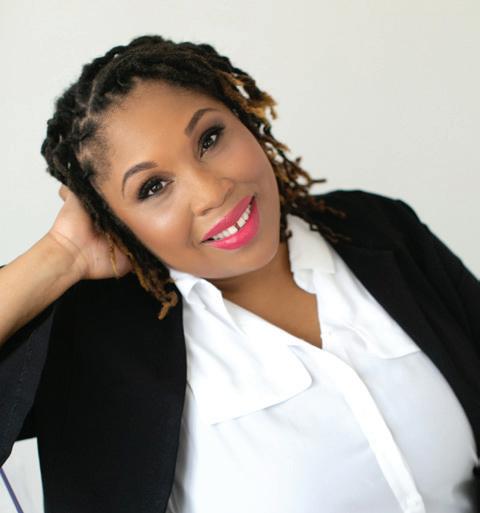
9 minute read
Barriers and Hurdles to the Advancement of Women Lawyers and Lawyers of Color
By Shana Woodard Graves
I. Introduction
Advertisement
During the past couple of years, you haven’t been able to log onto LinkedIn or any other social media, or read any business or career magazine or journal without bumping into the phrase “Diversity, Equity, and Inclusion” or “DEI.” Recently, this movement has been expanded to include belonging, lengthening this buzz phrase to DEIB. There has been much debate about how employers can make their efforts in the DEIB space meaningful and more than words. Despite this increased attention to and focus on DEIB by companies and firms across the country, women lawyers continue to feel the effects of inequity in the distribution of meaningful opportunities and resources in the workplace. A 2020 American Bar Association report notes: “White men continue to monopolize access to the prime work assignments, to the best mentors and sponsors with access and influence, and to insider information about the inner workings of the firm, often realized through socializing and relationship-building that continues to happen in maledominated spaces, such as the golf course.”1
Still many companies and firms have not addressed the two key impediments faced by women lawyers: (a) unequal access to the experiences that are building blocks for success, and (b) negative gender stereotypes and implicit biases. Women report being four to eight times more likely to be overlooked for advancement, denied a salary increase or bonus, treated as a token representative for diversity, lacking access to business development opportunities, perceived as less committed to her career, and lacking access to sponsors.2
Here are some statistics presented by the National Association of Women Lawyers in 2021:
• Only 22% of all Firm Equity Partners are women and 32% of non-equity partners are women
• Leadership Roles—12% Firm Managing Partner (up from 5% in 2010); 28% sit on a firm’s Governance Committee; and 27% hold a Practice Group Leader Role
• Pay Gap—2% of women make up the highest compensated attorneys at a firm, which is down from 8% in 2005 and 3% in 20163
Interestingly in the ABA’s study while women make up about 38% of the legal profession they hold nearly one-third of all federal judgeships, and they make up 41% of all state supreme court justices.
As reported in the American Bar Association’s 2020 Profile of the Legal Profession, only 5% of attorneys in the United States are African American.4 As a recent NALP report concluded: “The percentage of partners who are women or minorities has increased at least some every year, but the partnership ranks remain overwhelmingly white and male.5
Experienced women lawyers report that they are significantly more likely than their male counterparts to be overlooked for advancement; denied a salary increase or bonus; denied equal access to business development opportunities; become subjected to implicit biases, double standards, and sexual harassment; be perceived as less committed to their careers; and more.6
The practice of law is largely based on relationships. Networking and relationship building are key to obtaining key assignments and clients and to gaining quality mentorship and sponsorship. These are primary components of “access to success.” Many women lawyers, particularly women of color, identify a lack of “access to success” as a source of discontentment with the practice of law.
Participants in the 2020 ABA Report by Destiny Peery, Paulette Brown, and Eileen Letts talked about the persistence of the “Old Boys’ Club” and the ways that affinity biases and the choice to invest in people like oneself continues to shut women, particularly women of color, out of full participation and access in the legal workplace, leaving them looking in from the outside, lacking access to the resources and opportunities needed to thrive and succeed at the highest levels.7
This article will explore how biases lead to the exclusion of women lawyers from activities that are critical for gaining “access to success” and how that exclusion hinders the expansion of DEIB in the legal profession.
Examples of Exclusion from Arkansas Attorneys
“Today’s professional workplace continues to operate under a set of rules and expectations that were established decades ago, when men went to the office and women stayed at home, keeping house and raising children. Requiring flexibility, to get grocery shopping done or pick up children from school, is generally viewed as a weakness which will have a negative impact on a person’s career. As the bulk of this domestic labor tends to fall on women, even in a home where both partners work, women’s careers are disproportionately affected. This male-oriented culture extends to more than just the hours spent in the office. In the legal corporate world, networking events are frequently centered around golfing, gambling, or drinking whiskey in dark-paneled rooms with many leather-bound books. Women who want to succeed feel pressure to develop a talent for typically male-dominated activities or otherwise show they can hang with the boys. I’m at the point in my life and career, where I’m just not going to do that anymore. My professional value lies in who I am—not in who I can maybe pretend to be, and my employers will get the best work product from me when they respect and encourage that.”—Compliance
attorney
“I would often wonder why some of my colleagues seemed to always know information that I was not privy to. I found out that my male colleagues all played baseball together after work once a week. No one ever invited me. I just happened to end up in a conversation with someone in the office one day who didn’t realize that I hadn’t been invited and asked me if I was going to the next game. I later learned that some of my female counterpart’s husbands were also playing baseball and drinking with my male colleagues. This resulted in those female colleagues also having access to information that I did not. Ultimately, as an unmarried woman, I was denied access to critical information needed to navigate my workplace.”—Public
defender
“When I first came to my former company, among the attorneys, I was the only woman and the only person of color. My male boss and my male colleague would often have lunches, dinner, drinks, and other social gatherings with senior leadership, other key internal clients, and board members. I was never invited to attend which resulted in me not being recognized by most of senior leadership, being unknown by board members, and often being mistaken as a paralegal or a member of our support staff since I had never been introduced to critical stakeholders as an attorney, formally or informally.”—In-house

counsel
Shana Graves serves as Senior Counsel, US Privacy and Insurance Law. She received her undergraduate degree in Politics and International Relations from Hendrix College and her JD from UA Little Rock Bowen School of Law.
II. How women, specifically women of color, are excluded from social and recreational activities
The perception of who is the “best” or “most qualified” is not based on a set of objective criteria. The selection of lawyers for key assignments as well as the evaluation of their performance are subject to various biases, including similarity bias, confirmation bias, and affinity bias. These biases and the persistence of the “Old Boys Club” often lead to women lawyers, particularly women of color, being excluded from social and recreational activities such as lunches, dinners, golf, client meetings, and other outings that are key to relationship building.
Gender Gap
Women are far less likely than their male counterparts to be chosen as first chairs at trial or as leads on corporate deals.8
Diversity Tax
Many women and people of color pay a “diversity tax” to practice law. Women of color often experience this on an even larger scale. What is a diversity tax? A “diversity tax” is the “experience of discrimination, of otherness, and the necessity for extra labor experienced by diverse attorneys within the workplace because of their various marginalized identities.”9
A 2018 American Bar Association report from the Commission on Women in the Profession addressed the impact of gender and racial biases, particularly implicit biases, on women and women of color in the legal profession. The study found, consistent with past research, women of color were more likely to report that they had less equal access to high-quality work assignments and fewer fair opportunities for promotion.10
In her October 2022 article, Kee Tobar notes that for many diverse attorneys, the “diversity tax” often includes macroagressions and microagressions both directly and indirectly from their colleagues. She goes on to explain that this tax can also include being othered and passed over for mentorship, promotions, and other growth opportunities. Frequently an effect of being othered as a woman and/ or person of color in the legal field involves being excluded from social and recreational activities both hosted by their firm or company and those activities that are informally planned amongst colleagues.
III. Relationship gaps created by exclusion from social and recreational activities and how this affects women in practice
“Access to Success” describes a set of factors that address how women lawyers are generally perceived and the opportunities they are given to advance within their company or firm. These include access to key assignments, formal and informal networking opportunities, and client development and client relationshipbuilding opportunities.
The Visible Invisibility study reported that women of color felt they were missing out on desirable assignments, being denied formal and informal networking opportunities, missing client development and client relationship opportunities, and being denied promotion opportunities because of their race and/or gender. They also reported finding it harder to meet billable hour requirements and build a book of business necessary for advancement in law firms, which was due in part to their relative lack of access to the very opportunities and relationships that would allow them to do so.11
A consistent finding from the 2020 ABA study and past research is that women of color experience difficulty in getting access to mentors or sponsors who serve them in ways they see white men in particular being served by these relationships. Furthermore, women of color are especially likely to report that they lack access to mentors or sponsors who are well-connected and have power and influence to both clue them into important dynamics of the workplace and effectively advocate for them.12
These experiences with mentors and relationship building highlight the importance of considering the structures for creating, facilitating, and maintaining formal and informal relationships for attorneys throughout their career, particularly populations like women of color who experience more difficulty forging engaged relationships that lead to effective mentorship and sponsorship and feelings of belonging in the community.13
Exclusion from formal and informal social and recreational activities within a company or firm decreases women lawyers’ access to success because it hinders opportunities for networking and obtaining meaningful mentorship and/or sponsorship, as well as knowledge of the existence of informal and unwritten company or firm policies and practices which are necessary to navigating the internal structure in pursuit of advancement.
Conclusion
As the legal community continues to work to eliminate bias within the practice of law and discusses how to expand DEIB across the profession, it is crucial that we also address the tax associated with diversity. The diversity tax, as well as the exclusion that is often a product of this tax, are counterproductive to the DEIB goals of companies and firms. Companies and firms should create and promote policies surrounding bias reporting. Additionally, senior attorneys with privilege, power, and access to relationships should both leverage this privilege to help reduce and ultimately eliminate discrimination in the practice of law and to reach back and mentor and sponsor women attorneys and people of color by inviting them to social and recreational activities that will give them access to opportunities for networking, mentorship, and more prominent business opportunities.
Most employers, including legal employers, seem to understand diversity as it comes to recruitment and representation, but they continue to fail to understand the necessity of a focus on inclusion and retention.14
Biases, specifically affinity bias, the persistence of the “Old Boys’ Club,” and the tendency to invest in those like ourselves, causes women, particularly women of color, to be excluded in ways that limit their access to the opportunities and resources necessary to thrive and advance, preventing their full participation in the legal profession and the practice of law.
Endnotes:

1. Destiny Peery, Paulette Brown and Eileen Letts, Left Out and Left Behind: The Hurdles, Hassles, and Heartaches of Achieving Long-Term Legal Careers for Women of Color (A.B.A. 2020), available at: https:// www.americanbar.org/content/dam/aba/ administrative/women/leftoutleftbehindint-f-web-061020-003.pdf.
2. Roberta D. Liebenberg and Stephanie A. Scharf, Walking Out the Door: The Facts, Figures, and Future of Experienced Women Lawyers in Private Practice (A.B.A. 2019).
3. 2021 Report, National Association of Women Lawyers (NAWL) Survey on the Promotion and Retention of Women in Law Firms, available at https://www.nawl.org/d/ do/1120.
4. Kee Tobar, Paying the ‘diversity tax’ to practice law, A.B.A. J. (Oct. 19, 2022), available at https://www.americanbar.org/ groups/journal/articles/2022/paying-thediversity-tax-to-practice-law/.

5. Women and Minorities at Law Firms: What Has Changed and What Has Not in the Past 25 Years?, NALP Bulletin (Feb. 2018), available at https://www.nalp.
org/0218research.
6. Liebenberg and Scharf, supra note 2.
7. Peery, Brown and Letts, supra note 1.
8. Liebenberg and Scharf, supra note 2.
9. Tobar, supra note 4.
10. Commission on Women in the Profession and Minority Corporate Counsel Association, You Can't Change What You Can't See: Interrupting Racial & Gender Bias in the Legal Profession (A.B.A. 2018), available at www.americanbar.org/content/ dam/aba/administrative/women/Updated percent-20Biaspercent20Interrupters.pdf.
11. Id.
12. Peery, Brown and Letts, supra note 1.
13. Id.
14. Id. ■
By Skye Martin








